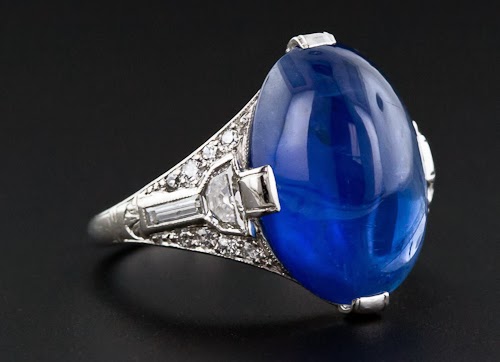Today I finally decided to talk about a colored gemstone that you CAN wear daily (but of course always treat it with care): Blue sapphires.
They seem to be everyone’s favorite, and let me tell you, that glowing velvety purplish blue makes me heart go pitter patter. But as you probably already know, buying sapphires can be tricky. There are lots of them out there that’ll look gorgeous to you, but may be heavily treated or even synthetic.
Sapphires are part of the corundum family. They rate a 9 on the
Mohs scale, just below diamond. But as you should already know, the Mohs scale isn’t exactly linear. There’s a big drop from the hardness of diamonds to sapphires.
There are lots of different fancy colored sapphires that are super dreamy in their own right
but for industry purposes when you hear sapphire, just assume that it’s the blue variety that’s being referred to.
The ideally colored and most expensive sapphire in the world is the Kashmir sapphire.
however, actual Kashmir sapphires were only mined for less than 10 years in the late 1800's, so if someone is claiming to have a real Kashmir sapphire, they’re most likely lying. There are several sapphires out there that resemble the Kashmir sapphire but people will search high and low for it and spend a pretty penny.
Treatments of sapphires are a scary subject because often times when buying them, sellers won’t disclose the treatments. Lots and lots of chain retailers sell treated stones. Don’t get me wrong, they can make a sapphire quite pretty but some of the treatments aren’t stable and in fact can mask some very major flaws in a sapphire that can risk its integrity (one good hit and BAM your sapphire is cracked in half).
Heat treatment: Heat treatment is a totally acceptable treatment by industry standards. Hell, most sapphires today are heat treated. If you do find one that’s not heat treated and has a gorgeous color, you’re looking at paying some big dinero for it.
There are some sapphires that are not normally heat treated. Montana sapphires are the first ones that come to mind. Montana sapphires have a wide array of colors and some of their blues resemble denim, but it is nice to know you have a completely conflict free sapphire. Montanas are rarely larger than a carat though. So they are small, but mighty.
Diffusion treatment: Sapphires that are treated by diffusion are usually heated to almost a melting point and elements are melted into the sapphire. Beryllium is the most commonly used element. The color only penetrates just under the surface of the stone though and can be rubbed off during faceting, and may eventually wear off with wear.



Lattice diffusion: Historically, vivid orange or yellow sapphires were almost always lattice diffused. Recently, however, the process has been used to turn dark inky sapphires to cornflower blue. This process is similar to old fashioned diffusion but the color penetrates deeper and is more permenenant. The most important thing for consumers to know is that any sapphire which has been heat treated may have been beryllium diffused as well. Only a gemological laboratory with the right equipment can determine if that is the case. Even a well intentioned dealer can easily be mistaken about sapphires in his inventory, since he may have received incomplete information from his supplier.
Fracture filled/surface dyed: Often times highly included stones will have their fractures filled in with glass that is dyed the color of the stone. This is sort of like dipping it in Elmer’s glue. Yes it’ll make the stone look prettier at first, but the filling can come out if it’s cleaned in a jet cleaner and then you’ll have a not-so-pretty stone that probably has some pretty bad damage to it.
Assembled stones: I guess technically this isn’t a "treatment" but it’s something to look out for. Sapphires can be made into "doublets" (similar to opals). The top of the stone may be a real sapphire, but the bottom may be synthetic spinel or garnet. A good way to tell is to look at it from the side. Sometimes you can tell that there’s a cap on the stone that way. Although some manufacturers are really good and have made the stones blend together nicely.
Synthetic stones: There are A LOT of synthetic sapphires out there and some of them are damned good. They have essentially the exact same chemical composition as a real sapphire so they can be really hard to spot (which is why they’re so scary). Just make sure to have it looked at by a very competent jeweler because there are telltale signs that can often be seen under magnification.
As always, buyer beware. If you’re buying a sapphire, just know what you’re getting. There’s nothing wrong having a pretty blue stone, but don’t pay for a heat treated only sapphire (or unheated for that matter) if you don’t have to.
I hope you all have a blingtastic day.
















No comments:
Post a Comment